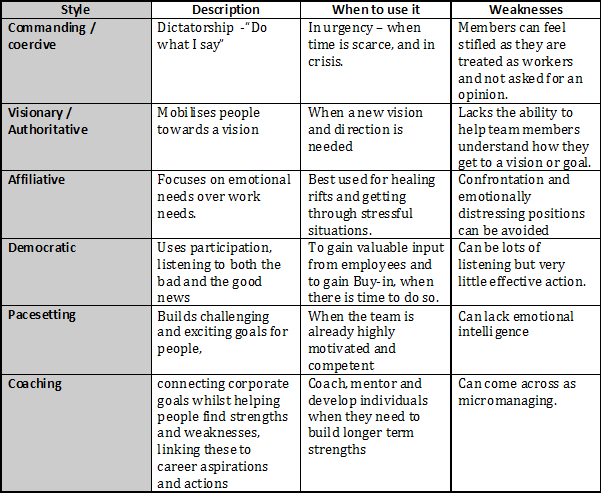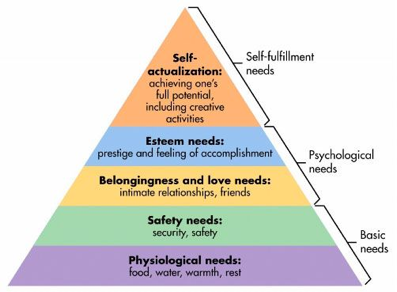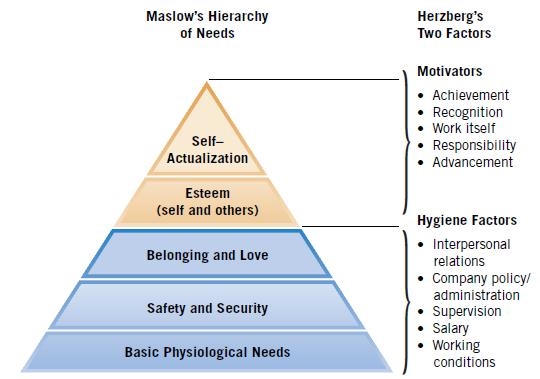Motivation in Project Management from the Project Manager’s Perspective
A project manager has to be able to plan the project, handle the stakeholders, create a risk analysis plan, handle the top management and the project team. But a topic that is often overlooked is the team motivation. The difference between a team that is highly motivated to solve a projects goal and a de-motivated team, could make the difference between a successful project, and a project that might never finish or is filled with complications. There is a growing awareness that people is one of the most important parts in a project. Since the beginning of 2000, the focus has been shifted from technical aspects (planning, budget optimizing, etc.) to more people-oriented aspects of project management - such as motivation. This applies for both practices and academic studies. [1] Motivated employees can increase productivity and efficiency. If the project manager makes an effort in motivating his employees, he could increase the team's efficiency, because motivated employees have less sick- and absence days, and the team members could make an extra effort to be on time. The quality of the work will also be better.[2]
There are several sources of motivation, which the project manager can focus on in the team. This article will show how a project manager can lead and motivate, go trough some of the motivational triggers, discuss some of the limitation the project manager has to motivate, and the limitations of the sources of motivation.
Contents |
Leading and motivating

Leadership in a group does not have single formular that is the right solution. Every team is different, and their needs and desires are different. There er leadership strategies one could possess in order to gain different goals. There are 6 different leadership strategies a project manager can use, according to Daniel Goleman.[4] There is not one leadership strategy which is better than another, when it comes to motivating the team, but in a particular situation there could be a strategy that works better. When taking a certain strategy it is important to be aware of the weaknesses it has. The project manager should not necessarily take on strategy, and keep it through the whole project. Being able to do good swaps between the different leadership styles is one of the strongest signs of a good leader.
'The commanding manager' would be good in cases where there is a lot of uncertainty or the project is diffuse, and the team need a person that they feel has control. The problems that can occur with this style, is that the personal development weight very little and create a frustrated team. It also demand a highly skilled leader, because if that is not the case, it would slow the project very much.
'The visionary manager' would be a good strategy where a project is forced to to do things differently than planned. In the projects critical path there was some big plans that had to be change for instance. As the commanding manager, the team needs a strong leader that takes the responsibility and lead. This demand the group too believe in the leader. It does not focus much on helping the the team members that can not keep up with the sudden change.
'The affiliative manager' is setting people first. It can be used to make amends between the team members, and create a good atmosphere. The weakness of this style is that it is not very work efficient. The work is not in focus and does not emphasise performance. If the project encounter a big problem this work style will have difficulties to get past it.
'The democratic manager' is leading with the group. Where the environment changes often for the group, and there are few constant in the project, this could be a good leadership style. It often makes sure that experienced team members are heard, and the best ideas comes forward. The bad side of this leadership is that every decision takes time, and it is therefore slowing the project down.
'The pacesetting manager' could work in groups that has a very experienced team. The manager leads by example, and focusing on getting the job done. He sets high goals for his team members, and does not accept poor performance. If the manager has succes with the style he can achieve goals fast. The downside of this style is that the work environment is not good. People are work tools, and if they are having a hard time, they get replaced. Therefore the work moral could become very low, and therefore slow the project if used wrong.
'The coaching manager' focusing on learning experience within the team. It can be good in long projects, where the team members lacks skills or they want personal development. It can however slow the project down, and if the leader lacks experience not have any effect at all.
Sources of motivation
A team member's motivation does not necessarily have to come from the project manager; the motivation can be both extrinsic or intrinsic. Intrinsic motivation means that the motivational energy comes from within the person. The person has a desire, a wish, to help achieve the goal, because it aligns with the person's own belief. An example of this could be if the team member finds the task he is assigned specially interesting, which motivates him to fulfill the task efficiently. Extrinsic motivation, on the other hand, is where the motivational energy is coming from an external source - and not from the team member himself. The team manager is a key component in extrinsic motivation. For example, the manager can either reward or punish his team members, in order to push them to do a certain task. There are several ways of giving extrinsic motivation to the team members. It is widely believed that intrinsic motivation is the best kind of motivation, but the project manager can help the team members achieve this.
Marslows hierarchy of needs
Abraham Marslow came up with the theory that there is a hierarchy of needs, and that one need has to be fulfilled before next one can be achieved.

Every member of a team has a need, something he/she wants. The promise of fulfillment of the needs is what drives us. Maslow's theory about the hierarchy of needs is a five-stage model that shows which needs drives us, and in which order to these occur, starting from basic needs and working its way up to fulfilling the human potential (self-actualization). The order of these needs is important, achieve satisfaction.
1. The first, the most basic need is the physiological needs. Lunch program at work could fulfill this need, or having fruits available during the day.
2. The second need is the safety needs. After being feed this issue is arising. To make sure the team members feel safe. This could be fulfill with clear communication so the employee never feel he is unsecure if he is doing his work right, he can depend on the others in team, and so on.
3. The third step is belongingness, and love needs. At this step the group activities is an example of fulfillment of this need. Teambuilding exercises or social events are some of the activities that can fulfill this need.
4.The fourth step is esteem needs. When a group member excel in the project, a job gets done, it is important to acknowledge the work he has done. This could be done by giving the employees a higher position, giving a bonus, but also a small thing as a ‘good job’ can satisfy this need.
5.With the four other needs fulfilled the team member can now reach the highest need, self-actualization and there are feelings of joy and euphoria. This step he has to reach himself and is therefore intrinsic motivation.
Feedback
Feedback is a powerfull management tool, that can either boost the motivation the right direction, but is also dangerous if used wrong. There is a general understanding that giving constructive positive feedback can be a good motivator for the employee. Giving negative feedback on the other hand can undermine the earlier exentric and intrinsic motivation and leave the person behind amotivated. When giving feedback there are various factors that need to be taken into consideration to make sure the feedback has the positive effect on the motivation.
1. The employees that is contributing most in a project often are those who need the feedback the most.
2. It is important too create a safety for the person that the feedback is pointing too.
3. Positive feedback is part of making the team member feel safe. There is a unwritten rule that says 50% constructive feedback 50% positive feedback. The positive feedback do not tell the person anything new, but stimulate the reward center in the brain and make the person open to the following critic.
4. In the feedback avoid being ambivalent, and be clear and specific in your motivation.
5. For the feedback to be relevant it is important the feedback is given frequently. It is not productive if it is given several months after the episode you want him to change on.[6]
Acknowledgement
The team has done four milestones in a project but has not had a single 'thank you', and their effort has not been acknowledged. Every member of the team will feel their work is not appreciated, and their motivation and efficiency will therefore drop drastically. This is not a situation any project manager want. Too avoid this, it is important to acknowledge peoples work with rewards for instance. It is important to carefully consider rewarding because it can have a negative effect on the intrinsic motivation. Why reward somebody for something he loves to do? If the reward is not specifically attached to a task he is assigned however(perks at the job for instance), the intrinsic motivation should not be affected. [7]
Freedom with responsibility
Autonomy is a important factor when talking motivation in projects. Most employee has a need and desire to affect a given project, and with no decisions that can affect the project they do not feel appreciated. Not feeling appreciated=> low motivation => low efficiency. This is one the the areas where intrinsic motivation can arise. This can be done by only setting a goal for the team members and letting them figure out themself how to do so.
Herzbergs two factor theory

One of the other famous behavioral scientist, Frederick Herzberg proposed another model in 1959. He said there is a fine line between motivation and simple hygiene factors. Hygeine factors is needed for motivation to be able to exist. It is the extrinsic factors as payment, job security, physical working conditions etc. that creates the foundation for the team manager to able to motivate the team. The hygiene factors as you can see in figure 3 is aligned with Marslows hierarchy of needs. The difference is that Herzberg believed that hygeine factors could not create satisfaction, only avoid dissatisfaction. For the motivator to create satisfaction there can not be dissatisfaction. Motivators on the other hand are intrinsic rewarding. It refers to the higher levels of Marslows hierarchy of needs such as personal development, and meaningful work. It is based on a research on 203 accountant and engineers, who were asked to recall when they had felt positive and negative at work and why. The problems with this theory is that it is biosed. The workers is likely to blame the negative feelings at the work place, and give the credit for the positive motivating factors to themself. It also does not take into account the people has different personalities. What one might see as a motivator somebody could hygiene factor.
Limitations to project motivation and discussion
Both intrinsic and extrinsic motivation will help the project, and both will achieve a higher efficiency. While intrinsic motivation is the one to aim for, because in the end it will create a need or desire to complete the project, extrinsic motivation could also have a positive effect. When discussing motivation in project management, it is important also to discuss the impact of the organizational motivation. The temporary manager, a temporary team and a fixed timeline, are some of the characteristics of project management. The organization has a equally opportunity to create motivation in the team. The organization can provide some of the core elements in motivation. The organization can provide the basic needs with for instance have a lunch arrangement in the company. They can always provide the surroundings for the employee, making him feel safe and be proud of his work. Then the project manager has the opportunity to give the employee some of the higher levels of motivation in Maslows hierarchy of needs. Earlier I said that organization have a equally chance to motivate the employee. Even tho the organization can not provide the the core elements, a good project manager can still motivate his team. [7]
Annotated biography
For further reading I suggest:
Schmid,Bernhard and Adams,Jonathan. (2008). Motivation in Project Management: The Project Manager’s Perspective This paper reviews the current literature on project and organizational motivation. It goes in depth with self-determination theory- SDT, and conduct a surveys about project managers ability to motivate the team. It gives a nice overview of the current literature aviable, but is to some extend superficial.
References
- ↑ Eight to Late (2008). Motivation in project management. [online] eight2late.wordpress.com. Available at: https://eight2late.wordpress.com/2008/08/29/motivation-in-project-management/ [Accessed 15 Sep. 2016]. The author behind this blog is co-founder and principal of Sensanalytics. He has written two books about management practices, and his work on the blog is mainly based on research papers .
- ↑ Callofthewild. (2016). Maslow’s Hierarchy of Needs – How to Motivate Your Staff. [online] callofthewild.co.uk. Available at: http://www.callofthewild.co.uk/library/theory/maslows-hierarchy-of-needs-how-to-motivate-your-staff/ [Accessed 16 Sep. 2016]. Call of the Wild is an independently-owned, limited company that teach management techniques to companies. They have won several awards for their work.
- ↑ 3.0 3.1 Edcucational Business-Articles. (2006). [online]. educational-business-articles.com.Available at: http://www.educational-business-articles.com/wp-content/uploads/six-leadership-styles.gif/ [Accessed 16 Sep. 2016].
- ↑ Goleman, Daniel. (2000). Leadership That Gets Results. "This puplication is about 6 different leadership styles. Da
- ↑ Simplypsychology. (2016). [online]. simplypsychology.org.Available at: http://www.simplypsychology.org/maslow-pyramid.jpg/ [Accessed 15 Sep. 2016].
- ↑ Halford, Scott. (2016). Five Steps for Giving Productive Feedback "This is a blog in The Entrepreneur discussing 5 tips for using feedback as motivation"
- ↑ 7.0 7.1 Schmid,Bernhard and Adams,Jonathan. (2008). Motivation in Project Management: The Project Manager’s Perspective "This paper focus on self-determination theory(STD) as motivation factor. "
- ↑ Managementstudyguide (2016). Herzberg’s Two-Factor Theory of Motivation. [online] managementstudyguide.com Available at: http://www.managementstudyguide.com/herzbergs-theory-motivation.htm/ [Accessed 26 Sep. 2016]. The author behind this blog is co-founder and principal of Sensanalytics. He has written two books about management practices, and his work on the blog is mainly based on research papers .